In the early 1920s, the first female students at Virginia Tech were not quite welcome. They had special rules to follow, there were no dormitories for women, and male students would throw water on them as they passed by the dorms. But one day, Ruth Terrett, a civil engineering student, decided to show the men she could do just as well as them. She donned a cadet uniform and climbed the university’s water tower, a tradition the male cadets undertook to prove their strength and ability. That day, Ruth proved that women, when given the chance, could do what men could.
Women throughout Virginia Tech’s history have encountered many obstacles, and have consistently overcome them. Sam Winn and I recently searched through Special Collections’ holdings to document these women and their achievements in the university’s history. Our work culminated in an exhibit at the Alumni Associations Women’s Weekend and a slideshow, entitled “Climbing the Water Tower: How Women Went from Intruders to Leaders at Virginia Tech.” Let me share with you a few of those milestones now, or you can view the PDF of our slideshow here.
Women join the student population
Many people know the story of the first female students: twelve women, including five full-time students, enrolled in 1921. Two years later, transfer student Mary Brumfield received a bachelor’s in applied biology, earning her master’s from VPI in 1925, the first woman to achieve either degree. But, did you know women began attending VPI several years earlier? They were allowed to sit in courses during the fall and spring for no credit and were admitted to summer classes, starting in 1916. 1921 was still a milestone year as it was the first all courses were open to women seeking a college degree, because there was “no good reason for not doing so,” as the university bulletin states.
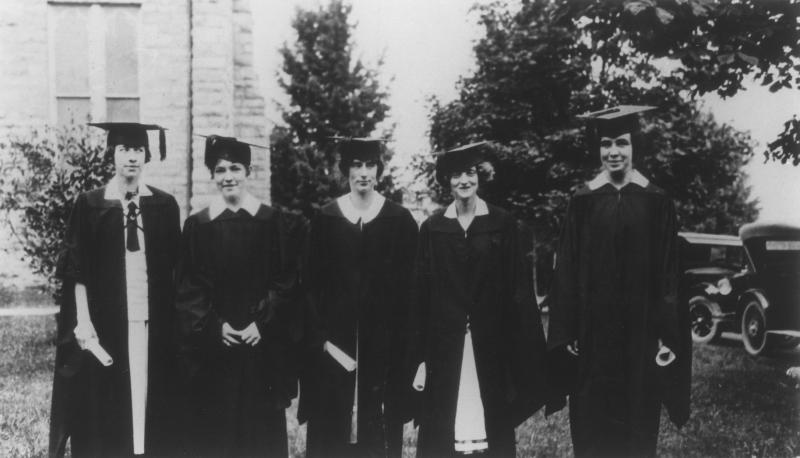
The first coeds, it must be admitted, were more than likely all white, given that segregation was legal due to Jim Crow laws and the Supreme Court decision in Plessy v. Ferguson (1896) upholding separate but equal racial segregation in the public sphere. It’s not clear when women of color were first admitted to the university, but international students from Mexico, China, Puerto Rico, and other places were already attending VPI by the 1920s. However, it wasn’t until 1966 that the first six African American women matriculated, thirteen years after the first African American man and 55 years after the first women. In 1968, Linda Adams became the first African American woman to graduate from Virginia Tech. (Read more about her on our previously blog post.)
There wasn’t much for women to do athletically in the early years, so Ruth Terrett, mentioned above, started an informal women’s basketball team before graduating in 1925. Women joined the cheerleading team in 1941, but were not officially recognized as members until the 1955-1956 school year. The first intramural women’s sport was basketball in 1967. Three years later, swimming became the first intercollegiate sport for women, and women were allowed to compete on the gymnastics team.
Because the Corps of Cadets did not admit women, Patricia Ann Miller was denied permission to enroll in Corps classes. Despite this, in 1959, she became the first woman commissioned during graduation when she successfully applied for a commission from the Army Women’s Medical Specialist Corps. Finally, in 1973, the Corps formed the L Squadron, exclusively for female cadets. Deborah J. Noss became the first female squadron commander and Cheryl A. Butler the first Black female cadet (and first Black female squadron leader the next year). In 1975, women were admitted to join the cadet band, and four years later, the L Squadron was disbanded to order to integrate women into the formerly all-male companies. In 1987, Denise Shuster became the first female regimental commander and in 2005, Christina Royal the first African American female regimental commander.
Female students who were not athletes or cadets had other ways of breaking the glass ceiling. In 1953, Betty Delores Stough became the first woman to receive a doctorate, in parasitology. Jean Harshbarger was the first woman elected class president for the Class of 1974. In 1968, Jaqueline D. Dandridge was the first woman of color in the homecoming court, and Marva L. Felder became the first Black homecoming queen in 1983.
Women join the workforce
What about the women working at VPI? Ella Agnew is often remembered as the first female home demonstration agent in the nation in 1910. When VPI became the headquarters for the Virginia Cooperative Extension in 1914, Agnew and the other agents became staff of the university. Agnew was also the first woman to receive VPI’s Certificate of Merit in 1926, and Agnew Hall was the first campus building named after a woman, in 1949. However, few realize she was not the first woman to work at Tech. In 1902, Frances Brockenbrough became Superintendent of the Infirmary, and the next year Mary G. Lacy became the first female Librarian and Margaret Spencer the President’s Secretary.
Other female agents worked for Extension during its early years at the university. In fact, although the African American division was headquartered at Hampton Institute, the agents were considered non-resident staff of VPI, first listed in the 1917 university catalog. One of these women was Lizzie Jenkins, who became the first Black female home demonstration agent in Virginia in 1913.
Women faculty members are first listed in the university catalog for 1921-1922. Mary Moore Davis ranked as a professor and worked as a state home demonstration agent in the Extension Division. She also established the home economics degree program at VPI. The first Dean of Women was Mildred Tate, who served from 1937 to 1947, and the first female academic dean was Laura Jean Harper, who in 1960 became the first Dean of the School of Home Economics. (Read more about her on our previously blog post.) Heidi Ford in 1970, Ella L. Bates in 1974, and Johnnie Miles in 1974 became the first female African American faculty members at Virginia Tech.
Women began achieving executive positions in the 1980s and 1990s. Sandra Sullivan was named Vice President for Student Affairs in 1982, and Peggy S. Meszaros served as the first (and currently only) female Provost from 1995 to 2000. Women started serving on the Board of Visitors in 1944, when VPI and Radford College merged. However in 2014, Deborah L. Petrine became the first female Rector in the university’s then 142-year history.
Women by the numbers
Virginia Tech has gone through enormous changes since its founding in 1872, especially in the growth of opportunities for women. Women on the staff have grown from one female administrative officer in 1902 to five women faculty members (only 4.7% of the faculty) in 1921 to 1,525 or 39.5% of the faculty in 2014. The student population has grown from 12 women or 1.3% of the students in 1921 to 13,241 women or 42.4% of the student population in 2014.
According to the Digest of Education Statistics, in Fall 2013, women accounted for 54.6% of enrolled students, 48.8% of faculty, and 54.5% of total employees (including faculty) in degree-granting public institutions in the U.S. However, the Digest also shows that women received only 30.8% of the degrees conferred by STEM schools in 2012-2013. So, as far as women have come, there’s still more to do.
Updated 10/28/2021: A reference to Kamini Mohan Patwary (M.S., 1955) was removed, as the information could not be confirmed.
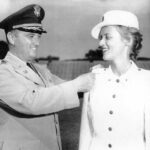
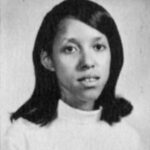
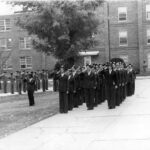
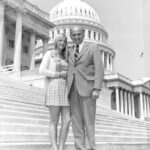

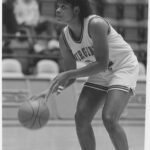
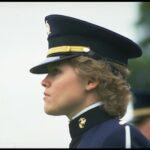
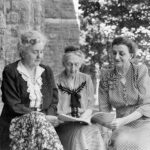
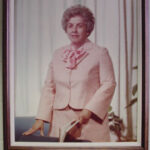
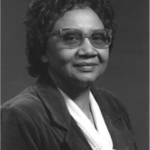


2 thoughts on “Climbing the Water Tower: How Women Went from Intruders to Leaders at Virginia Tech”